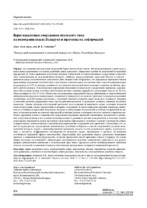| dc.description.abstract | На основании обследования сооружений берегозащиты более чем по 100 водохранилищам страны выполнена оценка современного состояния различных видов креплений с выявлением причин их разрушений и масштабов деформаций. В статье приведены результаты натурных наблюдений за берегозащитными сооружениями откосного типа, применяемыми на водохранилищах Беларуси. Наиболее распространенные крепления берегов и откосов – крепления в виде железобетонных монолитных либо сборных плит. Определено, что деформации креплений откосов представлены раскрытием межплиточных строительных, температурных и осадочных швов (зарегистрирована ширина раскрытия до 0,35 м), которые развиваются под комплексным воздействием ветрового волнения, колебания уровней и других факторов. В последующем деформации обнажившихся швов ведут к разрушению крепления. Деформация откосов в ряде случаев достигает значительных величин: линейная переработка (разрушение) откосов до 24,20 м, объем размывов до 4,25 м3/м пог. Физическое моделирование деформаций откосов, выполненное в гидротехнической лаборатории Белорусского национального технического университета на моделях грунтовых подпорных сооружений, защищенных железобетонным креплением с различной шириной раскрытия швов, позволило установить динамику и масштабы развития деформаций откоса при воздействии волнового и уровенного режимов, имеющих различные параметры. Данные натурных обследований креплений дали возможность выполнить оценку состояния покрытий откосов при разных сроках эксплуатации подпорных сооружений. В статье приведены причины и факторы, влияющие на устойчивость креплений. Результаты натурных и лабораторных исследований устойчивости креплений позволили установить влияние на развитие деформаций различных причин, к которым относятся: наличие в принятых расчетных проектных схемах и зависимостях определения параметров креплений объективных неточностей и допущений; отсутствие полноты учета условий волнообразования и уровенного режима водохранилищ; в исходных данных и материалах изысканий не всегда достоверно представлена информация о грунтовых условиях строительства объекта берегозащиты; технологические отклонения при строительстве сооружений и их креплений. Установлено, что одной из характеристик, определяющих динамическую устойчивость берегов и откосов сооружений в условиях водохранилищ Беларуси, наряду с вышеприведенными причинами, является состав размываемого грунта, характеризуемый, в частности, коэффициентом неоднородности несвязного грунта. Выявленный в процессе исследования устойчивости креплений эффект самоотмостки, образующейся при разрушении берега, сложенного несвязными грунтами с повышенной неоднородностью, позволил предложить способ крепления откосов и берегов. На основе данных натурных исследований и лабораторных экспериментов получены эмпирические зависимости для расчета профиля динамического равновесия с самоотмосткой двух типов. Предложен расчет комбинированного крепления откосов, состоящий из каменной отсыпки и синтетических фильтрующих материалов повышенной прочности. | ru |
| local.description.annotation | Assessment of the current state in respect of various bank stabilization with identification of causes of their destruction and deformation scale has been carried out on the basis of the survey pertaining to coastal protection structures in more than 100 reservoirs of the country. The paper presents results of field observations on bank slope protection structures which are used at water reservoirs in Belarus. It has been established that the most common protection of banks and slopes is strengthening in the form of reinforced concrete monolithic or prefabricated slabs. It has been determined that deformations of slope protection are represented by opening of tile-to-tile construction, temperature and settlement joints (it has been recorded opening width of 0.35 m) which develop under a complex impact of wind waves, fluctuations in levels and other factors. Subsequently deformations of exposed joints lead to destruction of the protection. Value of slope deformations reaches in some cases rather significant extent: linear processing (destruction) of slopes – up to 24.20 m; volume of erosion – up to 4.25 m3/m running. Physical modeling of slope deformations carried out at a hydro-technical laboratory of the Belarusian National Technical University while using models of ground retaining structures protected by reinforced concrete strengthening with various opening width of joints has allowed to determine dynamics and scope of slope deformations due to the influence of wave and level regimes having various parameters. Data of onsite investigations on protection have made it possible to assess the state of slope paving for various operational periods of retaining structures. The paper presents reasons and factors that affect the protection stability. The results of onsite and laboratory investigations on protection stability have permitted to determine that the following reasons influence on the development of deformations: presence of objective inaccuracies and assumptions in the accepted calculated design schemes and dependencies for determination of protection parameters; lack of completeness in registration of conditions for wave formation and level regime of reservoirs; initial data and survey materials do not always provide true information about ground conditions for construction of bank protection facility; technological deviations while constructing structures and their protection. It has been ascertained that one of the characteristics determining a dynamic stability of banks and slopes in structures under conditions of the reservoirs in Belarus along with the above reasons is a composition of the eroded soil characterized, in particular, by a inhomogeneity coefficient of loose soil. A self pavement effect identified during the study of protection stability and formed during destruction of a bank composed of loose soils with increased heterogeneity has made it possible to propose a method for protecting slopes and banks. Onsite investigations and laboratory experiments have permitted to obtain empirical relationships for calculation of dynamic equilibrium profile with self pavement of two types. The paper provides a calculation for combined slope protection consisting of rockfill and synthetic filter materials of increased strength. | ru |

